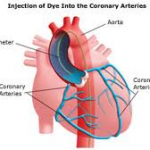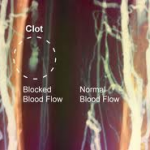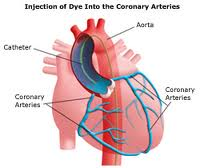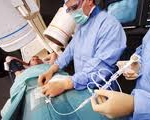Coronary angiography is the process of creating an angiogram of your heart using dye, a thin, flexible, hollow tube called a catheter and a rapid succession of x-rays resulting in a motion picture.
Patients are awake during the procedure so that you can follow instructions. Throughout the procedure you may be asked to take deep breaths, hold your breath, cough or place your arms in various positions. Your table may be tilted at times.
 Most cardiologists consider cardiac catheterization safe and low-risk. Depending on your personal pain threshold, getting an angiogram is relatively painless because local anesthesia is used. The whole process can usually take between 30 – 45 minutes.
Most cardiologists consider cardiac catheterization safe and low-risk. Depending on your personal pain threshold, getting an angiogram is relatively painless because local anesthesia is used. The whole process can usually take between 30 – 45 minutes.
A coronary angiogram is different than an ordinary, non-invasive x-ray because the dye is injected into the heart arteries with the catheter. This enables the x-ray to contrast the arteries with the surrounding body tissue. The cardiologist can then see which arteries are narrowed or blocked, even the very smallest ones, and recommend the best method to solve problem via balloon angioplasty, a coronary artery bypass graft (bypass surgery), stent placement, or treatment with drugs prior to / during heart valve surgery. Ultimately, the angiogram will also help determine how well the heart is functioning by looking carefully at its main chamber, the left ventricle.
The chance of any major problem from an angiogram is very small, but some problems can occur. In most cases, the problems occur within 2 hours after the test when you are in the recovery room. If the problem occurs during the angiogram, the test may not be completed. You may need urgent treatment that could include surgery.
- There is a chance of an allergic reaction to the iodine dye. The reaction can be mild (itching, rash) or severe (trouble breathing or sudden shock). Most reactions can be treated with medicines. Be sure to tell your doctor if you have hay fever, asthma, or iodine allergy or food allergies.
- There is a small chance that the catheter may damage a blood vessel or dislodge a piece of clotted blood or fat from the vessel wall. The clot or fat can block blood flow to the brain, arm, leg, or intestine (bowel).
- Bleeding from the needle site may occur. Also, a blood clot can form where the catheter was inserted. This may cause some blockage of the blood flow in the arm or leg.
- The iodine dye used for the test can cause water loss or direct damage to the kidneys. This is a special concern for people who have kidney problems, diabetes, or who are dehydrated. Special measures are used during the test to prevent problems for people who need an angiogram and have these conditions.
- There is always a small chance of damage to cells or tissue from being exposed to any radiation, even the low level used for this test.
- Heart attack
- Stroke
- Irregular heart rhythms (arrhythmias)
Discharge instructions
 Discomfort
Discomfort
- A pea-size lump in your groin or mild tenderness and bruising at the incision site is normal. You may take ibuprofen and apply a warm compress for discomfort.
- Mild headache can develop after the procedure. Drink plenty of fluids, especially water over the next few days; this will help flush out the contrast dye.
Activity
- Do not drive for 3 days after the procedure or until discussed with your doctor.
- Do not lift anything heavier than 10 pounds (e.g., gallon of milk) for 3 days.
Bathing/incision care
- You may shower 24 hours after the procedure. No baths, hot tubs, or swimming for 3 days.
- Remove the bandage before showering. Gently clean the site using soap and water. Dry thoroughly and apply a new bandage. If steri-strips are in place, allow them to fall off on their own.
- Check for signs of infection such as swelling, redness, yellow or green discharge, warm to the touch.
- Keep your dressing clean and dry. Change the dressing daily. Wash your hands before and after.
- Do not apply creams, lotions, or ointments on or near your incision.
- If bleeding occurs at the puncture site, lie down and apply firm pressure.
- If you received an angio-seal to close the artery puncture site, the body will absorb the collagen plug in about 60 to 90 days. During this time, carry your patient information card with you at all times.
Call your doctor’s office if:
- You notice bleeding, new bruising or swelling at the catheter site
- You develop increasing pain or discomfort at the catheter site
- You have signs of infection, such as redness, drainage or fever
- There’s a change in temperature or color of the leg or arm that was used for the procedure
- You feel faint or weak
- You develop chest pain or shortness of breath
If the catheter site is actively bleeding or begins swelling, apply pressure to the site and contact emergency medical services.

